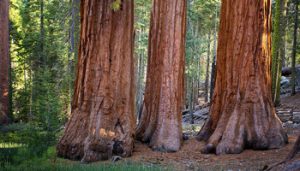Redwood forest once covered about 160,000 acres across Santa Cruz Mountains

By Mike Monroe

Mike Monroe
My favorite spot to displace the turmoil and tragedy of our times is under the shade of the redwood trees at Mt. Madonna County Park. In less than 15 minutes from Gilroy, I am transported to a quiet oasis of redwoods gently swaying in the breeze. My wife teases me because I always bring a book, as my easygoing trail walks typically include some time to sprawl underneath a redwood.
My usual travel pattern takes me to the top of Hecker Pass, entering the park via Pole Line Road then turning onto Valley View Road to the Azalea Knoll picnic area. My stroll begins at the Giant Twins trailhead. These trees are the only “old growth” redwoods accessible to the public at Mt. Madonna. Their age is unknown. Redwoods can live for more than 2,000 years and the plaque at their base recognizes they were thriving when Spanish explorers were looking for Monterey Bay in 1769. They are not considered “majestic” because their tops were destroyed by lightning, disqualifying them from the tallest trees contest. Still, standing in their presence is inspiring. It’s difficult to imagine a living entity surviving fire, floods, windstorms over hundreds of years and thankfully being spared from the woodman’s axe. They are truly wonders to behold and admire.
 Right in our own backyard, Mt. Madonna is where in 1853 the first local commercial logging operations began. The entire range surrounding Mt. Madonna was logged into the 1920s for redwood, Douglas fir, and tanbark oak, then followed by huge fires set by the lumbermen to remove all of the slash — tree limbs. bark, and duff. Only a few old growth trees were spared. These were tucked away in steep canyons or passed by because of their irregular shape.
Right in our own backyard, Mt. Madonna is where in 1853 the first local commercial logging operations began. The entire range surrounding Mt. Madonna was logged into the 1920s for redwood, Douglas fir, and tanbark oak, then followed by huge fires set by the lumbermen to remove all of the slash — tree limbs. bark, and duff. Only a few old growth trees were spared. These were tucked away in steep canyons or passed by because of their irregular shape.
This story was repeated all along the coastal belt of northern California. Prior to 1769, when the Spanish first began colonizing California, it is estimated that two million acres of virgin redwood forest stood relatively undisturbed by Native Americans. After the 1849 Gold Rush, the 1906 earthquake and the boom years following World War II, all that remained was slightly more than 100,000 acres of uncut redwoods. A staggering 95 percent loss. A disgrace and a display of disrespect toward the present and future generations in the opinion of John Muir and President Theodore Roosevelt.
In the Santa Cruz Mountains, experts estimated, the redwood forest covered about 160,000 acres. Today, there are about 10,000 acres of “old growth” trees (more than 250 years old), 8,000 of those acres are protected in state and county parks. Big Basin State Park is home to the majority of these old redwoods, and as our first state park it preserves about 5,000 acres of the ancient forest.
Let’s conclude with a happier story. Two scientists I know, Steve Singer and Zane Moore, prepared a research paper in 2014 which provided me with some excellent supporting information for this column. Their study attempted to identify all of the remaining old growth redwood stands in the Santa Cruz Mountains and, in particular, to count all the trees taller than 90 meters (295 feet) in height. They found 10 trees with the tallest being over 100 meters tall (328 feet) located in Big Basin.
That’s not the end of the tale though. A few years ago I was hiking with California State Parks volunteer Scott Peden. It was just the two of us walking along Waddell Creek on the Skyline-to-the-Sea Trail. I was jabbering about Mt. Madonna and he was busy with his camera, stopping it seemed, every few steps for another photo. I learned that Scott and Zane Moore had discovered another Santa Cruz Mountain Redwood that was 352 feet tall, with a 12-foot diameter and estimated to be 1,388 years old. The protocol these days, in order to protect the trees and forest understory, is not to reveal locations so as to protect them from careless damage or vandalism.
 Where is the tallest redwood in California? Officially, the Hyperion Coastal Redwood measured in 2006 and located within the Redwood National Park is the tallest at 380 feet. Officially, the General Sherman Giant Sequoia in Sequoia National Park in the Sierras is the biggest in terms of volume. Or is it? Because big tree explorers are now keeping their discoveries quiet, the rumor mill has posted discoveries of Sequoia sempervirens (coast redwoods) that are more massive than the General Sherman tree and approach (or exceed) the 3,000 year old age mark.
Where is the tallest redwood in California? Officially, the Hyperion Coastal Redwood measured in 2006 and located within the Redwood National Park is the tallest at 380 feet. Officially, the General Sherman Giant Sequoia in Sequoia National Park in the Sierras is the biggest in terms of volume. Or is it? Because big tree explorers are now keeping their discoveries quiet, the rumor mill has posted discoveries of Sequoia sempervirens (coast redwoods) that are more massive than the General Sherman tree and approach (or exceed) the 3,000 year old age mark.
Keep on sauntering!






